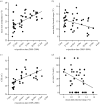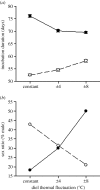Interactions among thermal parameters determine offspring sex under temperature-dependent sex determination
- PMID: 20685704
- PMCID: PMC3013385
- DOI: 10.1098/rspb.2010.1040
Interactions among thermal parameters determine offspring sex under temperature-dependent sex determination
Abstract
In many animals, temperatures experienced by developing embryos determine offspring sex (e.g. temperature-dependent sex determination, TSD), but most studies focus strictly on the effects of mean temperature, with little emphasis on the importance of thermal fluctuations. In the jacky dragon (Amphibolurus muricatus), an Australian lizard with TSD, data from nests in the field demonstrate that offspring sex ratios are predictable from thermal fluctuations but not from mean nest temperatures. To clarify this paradox, we incubated eggs in a factorial experiment with two levels of mean temperature and three levels of diel fluctuation. We show that offspring sex is determined by an interaction between these critical thermal parameters. Intriguingly, because these two thermal descriptors shift in opposing directions throughout the incubation season, this interactive effect inhibits seasonal shifts in sex ratio. Hence, our results suggest that TSD can yield offspring sex ratios that resemble those produced under genotypic sex-determining systems. These findings raise important considerations for understanding the diversity of TSD reaction norms, for designing experiments that evaluate the evolutionary significance of TSD, and for predicting sex ratios under past and future climate change scenarios.
Figures





Similar articles
-
The adaptive significance of temperature-dependent sex determination: experimental tests with a short-lived lizard.Evolution. 2005 Oct;59(10):2209-21. Evolution. 2005. PMID: 16405164
-
Ovotestes suggest cryptic genetic influence in a reptile model for temperature-dependent sex determination.Proc Biol Sci. 2021 Jan 27;288(1943):20202819. doi: 10.1098/rspb.2020.2819. Epub 2021 Jan 20. Proc Biol Sci. 2021. PMID: 33467998 Free PMC article.
-
Maternal and environmental effects on offspring phenotypes in an oviparous lizard: do field data corroborate laboratory data?Oecologia. 2009 Aug;161(1):209-20. doi: 10.1007/s00442-009-1366-1. Epub 2009 May 19. Oecologia. 2009. PMID: 19452172
-
The ecology and evolution of temperature-dependent reaction norms for sex determination in reptiles: a mechanistic conceptual model.Biol Rev Camb Philos Soc. 2017 Aug;92(3):1348-1364. doi: 10.1111/brv.12285. Epub 2016 Jun 14. Biol Rev Camb Philos Soc. 2017. PMID: 27296304 Review.
-
Predicting the effects of climate change on incubation in reptiles: methodological advances and new directions.J Exp Biol. 2021 Feb 24;224(Pt Suppl 1):jeb236018. doi: 10.1242/jeb.236018. J Exp Biol. 2021. PMID: 33627463 Free PMC article. Review.
Cited by
-
Transgenerational sex determination: the embryonic environment experienced by a male affects offspring sex ratio.Sci Rep. 2013;3:2709. doi: 10.1038/srep02709. Sci Rep. 2013. PMID: 24048344 Free PMC article.
-
Simulations with Australian dragon lizards suggest movement-based signal effectiveness is dependent on display structure and environmental conditions.Sci Rep. 2021 Mar 18;11(1):6383. doi: 10.1038/s41598-021-85793-3. Sci Rep. 2021. PMID: 33737677 Free PMC article.
-
Heat tolerance during embryonic development has not diverged among populations of a widespread species (Sceloporus undulatus).Conserv Physiol. 2013 Jun 11;1(1):cot018. doi: 10.1093/conphys/cot018. eCollection 2013. Conserv Physiol. 2013. PMID: 27293602 Free PMC article.
-
Habitat- and season-specific temperatures affect phenotypic development of hatchling lizards.Biol Lett. 2016 Oct;12(10):20160646. doi: 10.1098/rsbl.2016.0646. Biol Lett. 2016. PMID: 28120809 Free PMC article.
-
Temperature fluctuations and maternal estrogens as critical factors for understanding temperature-dependent sex determination in nature.J Exp Zool A Ecol Integr Physiol. 2018 Apr;329(4-5):177-184. doi: 10.1002/jez.2183. Epub 2018 May 28. J Exp Zool A Ecol Integr Physiol. 2018. PMID: 29806743 Free PMC article. Review.
References
-
- Bull J. J. 1983. Evolution of sex determining mechanisms. Menlo Park, CA: Benjamin Cummings Publishing Co
-
- Fisher R. A. 1930. The genetical theory of natural selection. Oxford, UK: Clarendon Press
-
- Bulmer M. G., Bull J. J. 1982. Models of polygenic sex determination and sex ratio control. Evolution 36, 13–2610.2307/2407962 (doi:10.2307/2407962) - DOI - DOI - PubMed
-
- Mitchell N. J., Allendorf F. A., Keall S. N., Daugherty C. H., Nelson N. J. 2009. Demographic effects of temperature-dependent sex determination: will tuatara survive global warming? Glob. Change Biol. 16, 60–7210.1111/j.1365-2486.2009.01964.x (doi:10.1111/j.1365-2486.2009.01964.x) - DOI - DOI
-
- Janzen F. J. 1994. Climate change and temperature-dependent sex determination in reptiles. Proc. Natl Acad. Sci. USA 91, 7487–749010.1073/pnas.91.16.7487 (doi:10.1073/pnas.91.16.7487) - DOI - DOI - PMC - PubMed
Publication types
MeSH terms
LinkOut - more resources
Full Text Sources
Miscellaneous

